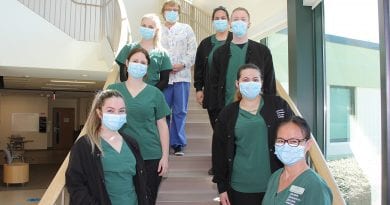STCC Partners with Head Start to Create Online Preschool
An Effective Pivot
Springfield Technical Community College (STCC) student Hannah Lavigne is leading a small class of preschoolers in story time and an activity. She had to plan the lesson and carry it out. She selected the book Where Do Balloons Go? by Jamie Lee Curtis, a story about a lost balloon and its many adventures, and came up with a related activity.
As teachers do, she held the book up to make sure the little ones could see the colorful pictures.
But the students in this Head Start class were no wiggle worms clustered around this student teacher’s feet. They were each in their own home, watching their teacher and classmates on a computer screen.

And from her own home, Lavigne conducted the activity she planned, showing them two balloons, one buoyant with helium, the other gravity-bound. When Lavigne let go of the helium balloon, students squealed when it disappeared from the camera’s eye and their view, drifting upward to her bedroom ceiling. Maybe, like the balloons in the book, this balloon was having a dance party in the sky. They watched as the air-filled balloon dropped to the ground.
Welcome to Head Start at Home.
Last fall, Lavigne, like all STCC early-childhood practicum students, completed her practicum teaching online.
In March, when the pandemic shut down schools, closed daycare centers, and sent legions of college students into intensive online learning, professors in STCC’s early-childhood education program didn’t panic; they adapted.
About 55 students are enrolled in STCC’s one-year certificate program or two-year associate-degree program in early childhood education, including both Spanish-speaking and English-speaking cohorts.
Students are required to spend 150 hours teaching in the field under the guidance of mentor teachers. Prior to pandemic shutdowns, they logged those hours in a variety of settings: family childcare operations, private childcare programs, public-school preschool programs, and federally funded Head Start centers.
When many centers closed down, STCC students were left without their practicum settings to return to. Luckily, many had already logged time in the field. And then the state reduced the teaching requirements to 75 hours.
“We sort of had to just muddle through and scrape ourselves over the finish line,” said STCC Assistant Professor Aimee Dalenta, who works in the early-childhood education program. “But then, in the summer, we were in a real pickle.”
To meet that need, Dalenta created a six-week-long, fully virtual preschool for children ages 3-5 in which STCC students took turns planning lessons, teaching them, and serving as assistant teachers.
The virtual preschool was a hit for both the students who gained practicum experience and the participating families whose children had enrichment experiences. STCC students not only learned about good teaching, they gained first-hand experience in something all teachers understand: the need to adapt to whatever circumstances they face.
“We spent a lot of time talking about the flexibility it requires to teach online,” Dalenta said. “We talked about how marketable it makes them in an uncertain future. Working with preschoolers online is not an easy thing to do.”
For the fall semester, though, Dalenta knew the STCC virtual preschool could not be replicated. While it was a rich and successful summer experience, it was not a sustainable model. It also lacked something important to all teachers in training: the opportunity to work with experienced teachers, who provide grounding for student teachers and model teaching strategies. They needed mentors.
Dalenta reached out to the Holyoke Chicopee Springfield Head Start program, long a placement for STCC practicum students.
Mahera Chiarizo, HCS Head Start’s director of Education, was eager to team up with Dalenta to create a good learning experience for STCC students in pandemic conditions.
“This was a first for all of us, doing something remotely,” Chiarizo said. “With the right ideas and motivation, it became a very successful partnership.”
Chiarizo said the ongoing connection between STCC and Head Start has been a fruitful two-way street for many years.
“This is a pipeline for employment,” she said. “We really look at these partnerships as an opportunity to grow the field.”
Relying on the technology platform ClassDojo, which is used by Springfield public schools, STCC students were able to join their mentor teachers for virtual parent meetings, lesson planning, teaching, even taking advantage of professional-development opportunities presented to Springfield teachers.
Though classes were taught remotely, the practicum sought to replicate typical student-teaching experience in other ways — for example, starting off with a small assignment and gradually building up to increasing amounts of responsibility around both planning and teaching. And just as they do with in-person practicum placements, students are encouraged by their mentor teachers to reflect on what worked well with a given lesson, what they might have done differently, and what they learned from the experience.
“It’s the same approach as if they were in the classroom, but it’s virtual,” Chiarizo said.
While teaching preschoolers via computer is not easy, Dalenta believes the principles in which student teachers need to ground themselves are enduring, whether in person, on ClassDojo, or via any other technology platform.
“The fundamentals of good teaching pedagogy,” she said, “will always be the same until the end of time.”



